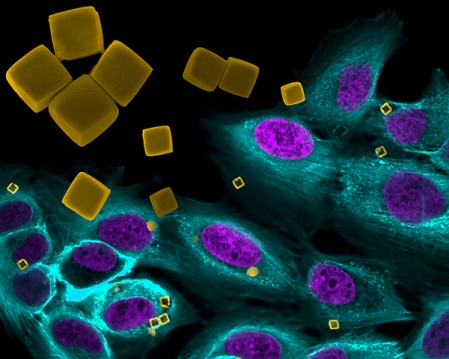
Snapshots of Life: Finding a Cube for Cancer

Jenolyn F. Alexander and Biana Godin, Houston Methodist Research Institute; Veronika Kozlovskaya and Eugenia Kharlampieva, University of Alabama at Birmingham.
Creative photographers have long experimented with superimposing images, one over the other, to produce striking visual effects. Now a group of NIH-supported scientists at Houston Methodist Research Institute and their colleagues have done the same thing to highlight their work in the emerging field of cancer nanomedicine, using microscopic materials to deliver cancer treatments with potentially greater precision. In the process, the researchers generated a photographic work of art that was a winner in the Federation of American Societies for Experimental Biology 2015 Bioart competition.
The gold cubes are man-made polymer microcarriers, just 2 micrometers wide (by comparison, human cells generally range in diameter from 7 to 20 micrometers), designed to transport chemotherapy drugs directly to tumor cells. These experimental cubes, enlarged in the upper left part of the photo with a scanning electron microscope for better viewing, have been superimposed onto a second photograph snapped with a confocal fluorescence microscope. It shows similar cube-shaped microcarriers (yellow) inside cultured breast cancer cells (nucleus is purple, cytoplasm is turquoise).
Although the cubes inside the cells are empty and won’t kill the tumor cells, this dry run illustrates an interesting finding: of three breast cancer cell lines studied, all preferentially internalized cubed microcarriers over spherical ones [1]. In one cell line incubated for 24 hours with the differently shaped microcarriers, the cubes were internalized 8.8 fold more often than the spheres. While this discovery is yet to be fully explained, the researchers suspect that the flat surface of the cubes allows better adherence to the cancer cell membrane than spheres. As a result, cancer cells can more readily haul them inside.
Biana Godin, a senior author on the paper and researcher at Houston Methodist, will soon load these cubes with chemotherapy drugs and begin testing them in animals with tumors. They’ll explore how the elasticity and other features of these tiny cubes influence their ability to deliver treatment effectively. Here’s to thinking outside the box and inside the cube.
Reference:
Cubical Shape Enhances the Interaction of Layer-by-Layer Polymeric Particles with Breast Cancer Cells. Alexander JF, Kozlovskaya V, Chen J, Kuncewicz T, Kharlampieva E, Godin B. Adv Healthc Mater. 2015 Dec;4(17):2657-66.
Links:
NCI Alliance for Nanotechnology in Cancer (National Cancer Institute/NIH)
Godin Lab (Houston Methodist Research Institute)
BioArt (Federation of American Societies for Experimental Biology, Bethesda, MD)
NIH Support: National Cancer Institute






















.png)











No hay comentarios:
Publicar un comentario